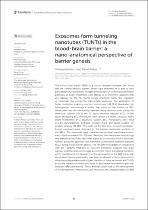| dc.contributor.author | Mentor, Shireen | |
| dc.contributor.author | Fisher, David | |
| dc.date.accessioned | 2022-10-18T08:08:23Z | |
| dc.date.available | 2022-10-18T08:08:23Z | |
| dc.date.issued | 2022 | |
| dc.identifier.citation | Mentor, S., & Fisher, D. (2022). Exosomes form tunneling nanotubes (TUNTs) in the blood-brain barrier: A nano-anatomical perspective of barrier genesis. Frontiers in Molecular Neuroscience, 15, 938315. https://doi.org/10.3389/fnmol.2022.938315 | en_US |
| dc.identifier.issn | 1662-5099 | |
| dc.identifier.uri | https://doi.org/10.3389/fnmol.2022.938315 | |
| dc.identifier.uri | http://hdl.handle.net/10566/8062 | |
| dc.description.abstract | The blood-brain barrier (BBB) is a robust interface between the blood
and the central nervous system. Barrier type endothelium is able to limit
paracellular (PC) movement, relegating molecular flux to the transendothelial
pathways of brain endothelial cells (BECs). It is, therefore, apparent that
any leakage via the PC shunts would effectively nullify the regulation
of molecular flux across the transcellular pathways. The application of
higher-resolution scanning electron microscopy (HR-SEM) illuminates the
heterogenous, morphological profile that exists on the surface of BEC
membranes and the relationship between these ultrastructures during the
molecular construction of the PC space between adjacent BECs. In this
study developing BEC monolayers were grown on mixed, cellulose esters
insert membranes in a bicameral system. | en_US |
| dc.language.iso | en | en_US |
| dc.publisher | Frontiers Media | en_US |
| dc.subject | Nanotubes | en_US |
| dc.subject | Nanovesicles | en_US |
| dc.subject | Exosomes | en_US |
| dc.subject | Bioscience | en_US |
| dc.subject | Biology | en_US |
| dc.title | Exosomes form tunneling nanotubes (TUNTs) in the blood-brain barrier: A nano-anatomical perspective of barrier genesis | en_US |
| dc.type | Article | en_US |

